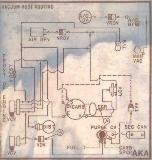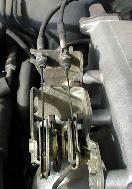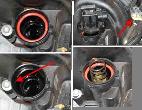EGR, PCV, Ignition Problems
Ignition Switch Replacement, 1996 - 2000 Caravan
http://www.ehow.com/how_7469303_replace-switch-2000-dodge-caravan.html
1 - Remove the negative battery terminal.
2 - Remove the lower dashboard cover and the plate of the steering cover. Remove the screws holding them in place with a screwdriver. Also, remove the fuse box cover located between the driver's door and the steering wheel column.
3 - Trace the ignition wires that run from the steering wheel cover to the back of the fuse panel. Unscrew the screws holding these wires in place to the rear of the fuse panel.
4 - Loosen the old ignition switch by prying it gently out with a slotted screwdriver, and remove it. Slide the new ignition switch into place, feeding its wires through the steering wheel column.
5 - Reconnect the ends of the ignition switch wires to the rear of the fuse box. Replace the fuse box cover. Test the new ignition switch by starting your Dodge Caravan.
6 - Replace the steering cover plate and dashboard cover, and reconnect the negative battery terminal.
Symptoms of a Bad
Ignition Relay
The one obvious symptoms of a bad ignition relay is when the starter simply does not turn over. But there are other behaviors that can be the sign of a degrading ignition relay.
SLUGGISH OR UNRELIABLE STARTS. If you replace a "bad" starter because of slow performance, and your new starter does the same thing, test your starter relay. Take a similar relay from another circuit in your vehicle, such as the blower motor relay, and swap it with the ignition relay to test this out.
Poor starter performance can be caused by several things: weak alternator or battery, a bad ignition switch, or the starter motor itself. But it is worth ruling out the relay first; it could save you a lot if time and expense.
EGR INFO
[http://forums.vmag.com/pm-1000/messages/1541.html.]
[Arizona Chevy Parts Discount dealer:http://www.parts.com/partlocator/index.cfm?siteid=213835 ]
My 1996 Chev Blazer 4x4 (automatic) has a problem when accelerating from a stopped position, until it gets past 30 MPH, then it really "takes off"! I was told that the problem is with the EGR (ERG?) valve. How much does this usually cost to repair? Is it something that one can do themself? Can the part be purchase at a lower cost any where on the internet? Is it possible it could be something other than this valve? I was told that '95-'96 Blazers frequently have this problem. It has about 68,000 miles, and runs well otherwise. I faithfully add carb/fuel injection treatment to gas each time I fill-up, and this usually helps, but only until it gets to below half a tank. Any advise would be greatly appreciated, as it's killing my gas mileage! (6 cyl)Is now only getting about 12mi. to the gallon!
: Thanks!!
Posted by aday on November 03, 19100 at 11:05:25:
In Reply to: '96 Blazer EGR valve problem??? posted by RS on November 03, 19100 at 10:55:48:
I seriously doubt that this is an EGR valve problem. At face value your symptoms sound similar to transmission that won't shift into first. If you start off in second you would have symptoms similar to yours. The symptoms don't match an EGR valve problem.
Most EGR valves are easy to put on. The price of the valve is usually the kicker. Call the local parts store or your dealer's parts department.
--------------
[http://www.jonko.com/articles/egr_valve.htm ]
"My guess is that the EGR valve is NOT the problem, but your mechanic received an EGR trouble code from your computer system while running a diagnostic test. There are more components of the EGR (Exhaust gas Re-circulation) than the valve and any of those can cause an EGR trouble code."
---------
[http://members.aol.com/carleyware/library/misfire.htm ]
"Lean misfire" can occur when the air/fuel mixture is too lean (not enough gasoline in the mixture) to burn. This can be caused by a dirty, clogged or inoperative fuel injector; air leaks; or low fuel pressure because of a weak pump, restricted filter or leaky pressure regulator. Low fuel pressure would affect all cylinders rather than an individual cylinder, as would most air leaks. A leaky EGR valve can also have the same effect as an air leak.
A lean mixture in a single cylinder can be caused by a leaky intake manifold gasket, air leakage past injector O-rings, a leaky EGR valve (if the valve is adjacent to the cylinder intake port) or a dirty, plugged or inoperative fuel injector. Loss of compression because of a leaky (burned) exhaust valve or a leaky head gasket can also affect the spark burn line in the same way.
Note: If the spark burn lines for all the cylinders are higher than normal (indicating a lean fuel mixture), the underlying cause would be something that affects all cylinders such as an intake manifold leak, leaky vacuum hose, leaky EGR valve, leaky throttle gasket or low fuel pressure (weak fuel pump or bad pressure regulator).
Intermittent misfires are the worst kind to diagnose because the misfire comes and goes depending on engine load or operating conditions. They seem to occur for no apparent reason. The engine may only misfire and run rough when cold but then smooth out as it warms up. Or, it may start and idle fine but then misfire or hesitate when it comes under load. Also, it may run fine most of the time but suddenly misfire or cut out for no apparent reason. Intermittent misfires can be a real challenge to diagnose, so let's start with a steady misfire in one cylinder before moving on to intermittent misfires.
----------------
[http://www.babcox.com/editorial/us/us50326.htm ]
Random misfires that jump around from cylinder to cylinder also will set a misfire code (P0300). The underlying cause is often a lean fuel condition, which may be due to a vacuum leak in the intake manifold or unmetered air getting past the airflow sensor, or an EGR valve that is stuck open.
---------
[http://www.owenautomotive.ca/95%20Saturn.pdf ]
Another possibility is for a portion of the engine compartment sub-wiring harness rubbing through and shorting out against the intake manifold, usually this will cause intermittent misfire, stalling or no start conditions but are almost always accompanied with multiple Diagnostic Trouble Codes (DTC's) so if there were no codes on your car it would unlikely to be the cause of your failure.
--------------
[http://home.att.net/~jroal/repair.html. ]
Many mechanics will claim that the EGR valve and sensor should both be changed if either is faulty. This is generally not true. There were cases in the 1980's when redesigned valves would not work without a redesigned sensor but generally either one or the other is the problem, not both.
-----------
Idle
Air Control, Vacuum
[Note: "Close-Circuit" the Vacuum lines going to the Cruise Control module, (in case this is leaking or electrically disabled)
[Picture of Vacuum Routing: http://www.broncotech.com/ubb/Forum1/HTML/000352.html ]
 [Cruise Control Actuator (the module behind the battery in the Trans Sport) http://auto.howstuffworks.com/cruise-control2.htm. ]
[Cruise Control Actuator (the module behind the battery in the Trans Sport) http://auto.howstuffworks.com/cruise-control2.htm. ]
 One of the cables is connected to the gas pedal, the other
to the vacuum actuator.
One of the cables is connected to the gas pedal, the other
to the vacuum actuator.
In the picture above, you can see two cables connected to a pivot that moves the throttle valve. One cable comes from the accelerator pedal, and one from the actuator. When the cruise control is engaged, the actuator moves the cable connected to the pivot, which adjusts the throttle; but it also pulls on the cable that is connected to the gas pedal -- this is why your pedal moves up and down when the cruise control is engaged.
[ http://www.ford-trucks.com/forums/archive/topic/100448.html ]:
It is unusual for 2 vacuum lines to come off. One possible problem is the vacuum modulator on the transmission starts to leak and the engine vacuum sucks up the fluid. This fluid softens the vacuum hoses and they fall off. Follow the vacuum line to the modulator on the side of the transmission. The vacuum modulator is only about $12 though it may be inconvenient to get at.
-------------
[http://members.tripod.com/FieroDough/troubleshooting.htm.]
Engine stumbles on acceleration or misses throughout driving range
: Vacuum leak in intake system or vacuum hoses
[http://hometown.aol.com/zz502hoss/id18.htm.]
Idle Speed:
The integral IACV (Idle Air Control Valve) is a stepper motor that moves a liner valve off a seat allowing air to bypass the throttle valve. Since the ECM knows coolant temperature (CTS Coolant Temperature Sensor) and a colder engine requires more energy to idle, consistent idle speeds are maintained, hot or cold. This is especially nice for in the BossHoss application since excessive idle speed can result in unexpected creep when idling while in gear (eg: at a stop light).
[ http://www.4dsc.com/articles/drivetrain/ve_ecs/ve_ecs.shtml ]
Idle Air Control Valve (IACV)-Air Regulator
This provides an air by-pass when the engine is cold for a fast idle during warm-up. Wax, a piston and a spring are located in the valve. When the coolant temp is low, the valve allows air to pass through. As the coolant temp rises, the wax expands to shut off the air by-pass, which decreases idle speed down to normal.
Idle Air Control Valve (IACV)-Auxiliary Air Control (AAC) Valve:
The ECM actuates the IACV-AAC by an on/off pulse. When the ECM transmits an on pulse, the valve opens to let more air into the intake, thus increasing idle speed.
Exhaust Gas Recirculation (EGR) Valve:
This controls the quantity of exhaust gas to be fed into the intake manifold through a vacuum actuated taper valve. This vacuum is applied in response to the opening of the throttle valve.
EGR Control (EGRC)-Solenoid Valve:
The solenoid valve responds to an on/off signal from the ECM. When it's off, a vacuum signal from the throttle body is fed into the EGR valve. When the signal is on, an electric plunger shuts off the vacuum to turn off the EGR valve.
---------
PCV
VALVE, & location on certain GM engines
[http://www.impalahq.com/HowTo/PCV.html ]
 Where the *%#@^!! is the PCV valve?!?!
Where the *%#@^!! is the PCV valve?!?!
The PCV valve is under this cap. It is located on the passenger side of the engine. That is the alternator on the left side of this photo.
Remove the electrical connector by lifting up the tab and gently pulling. The arrow is pointing to the removed connector. Then gently push down and turn the cap counterclockwise. It is spring loaded and is similar to a radiator cap.
Here is the PCV valve attached to the cover. Notice there is a black o-ring on the bottom of the valve.
The valve may not come out with the cap. This is what you would see if this happens.
This is what the whole thing looks like when you take it apart. Inspect the o-ring for damage and replace if required.
There is another o-ring for the seating surface of the cap. There may be a lot of debris around the o-ring.
Carefully clean this area and remove the o-ring. Make sure nothing falls into the engine. Inspect the o-ring for damage. Replace as required.
Here is a close up view of the o-ring.
-----------------
[Hall Effect Sensor Readings, CMS, PDA, and all the rest...]
(Link to image of graph (www.interro.com/images/digtrace53.gif)
PDAs – personal digital assistants. / The PDA ignition meter in figure 1 can be used with one hook-up ( KV Probe ) to test for firing voltage. {Shows a number on an LCD screen - rj]. This meter will detect the intensity of the spark by recording the highest voltage detected in the MAX window.
The lab scope ["Oscilloscope" - rj]( fig. 2 ) is setup for testing a variable reluctance crank sensor and ( fig. 3) is setup to test a Hall effect signal. If your scope screen looks like either one of these while the engine is cranking, the next step is to determine why there is no crank signal.... Figure 7 is a good crank and cam sensor signal. [Ergo, it requires an oscilloscope to read a Hall-Effect device. So, next mystery... - rj]
--------------------
 [Cruise Control Actuator (the module behind the battery in the Trans Sport) http://auto.howstuffworks.com/cruise-control2.htm. ]
[Cruise Control Actuator (the module behind the battery in the Trans Sport) http://auto.howstuffworks.com/cruise-control2.htm. ] One of the cables is connected to the gas pedal, the other
to the vacuum actuator.
One of the cables is connected to the gas pedal, the other
to the vacuum actuator. Where the *%#@^!! is the PCV valve?!?!
Where the *%#@^!! is the PCV valve?!?!